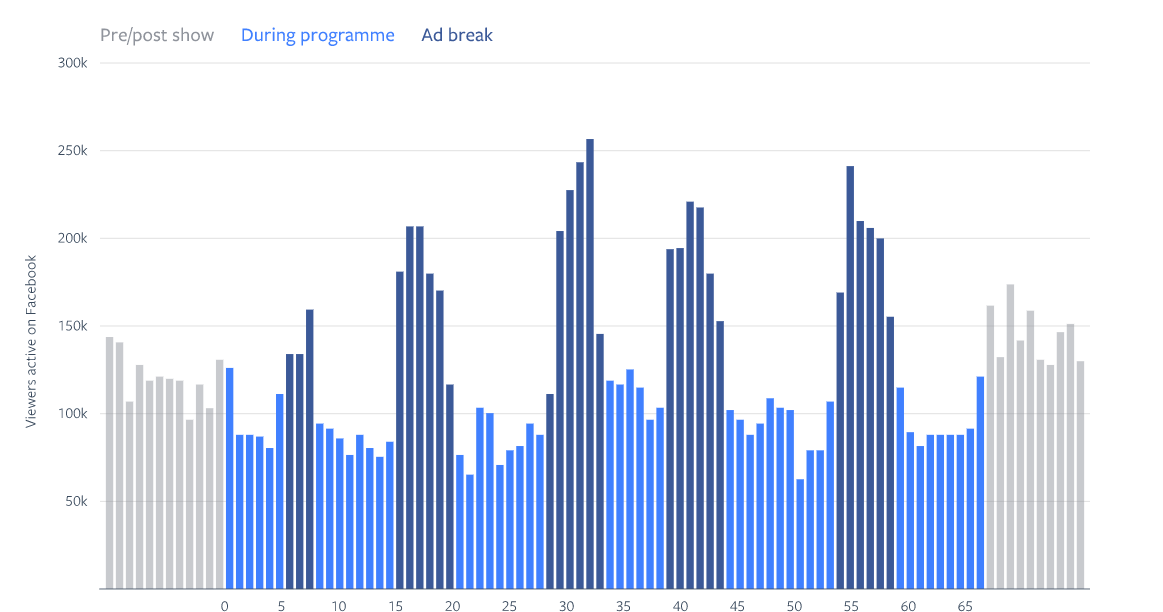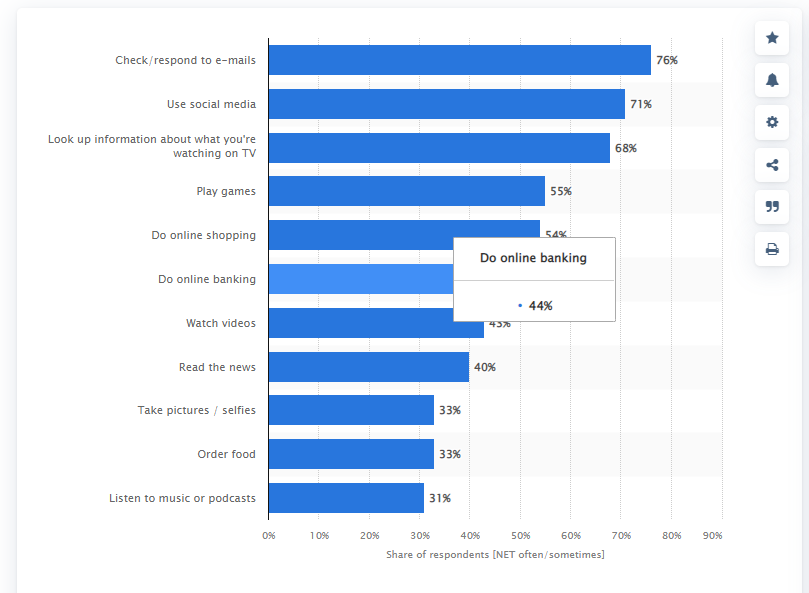Picture this scenario. You’re sitting at home watching TV while scrolling through Instagram, keeping up with the activities of your friends and favorite brands. Half of your attention is on the show that you sat down to watch. The other half is on your device. Neither has your undivided attention.
In the world of mobile devices, this type of multitasking is increasingly common. This makes life more difficult for marketing teams. That’s because a lot of traditional marketing and website content relies on being its audience’s sole focus, even for a short time. People are also increasingly expecting personalized recommendations online, so content can no longer be a cover-all.
Not every brand uses TV marketing, but plenty still do. Those that do, face fierce competition for their customers’ attention with social media. This is where second screen marketing comes in. We’re going to explore it in more detail and help you to implement it into your marketing strategy.
What is Second Screen Advertising?
Second screen advertising (or marketing) is any marketing technique that targets customers on their second device where they may not get the full impact of a TV advertisement. The classic example of this is when a consumer is watching a TV show and using social media on a mobile device, like a smartphone or tablet.

Other examples of secondary media include:
- An e-reader
- A laptop or desktop
- Wearable smart tech
There isn’t one explanation as to how second screen use became so prevalent. A commonly cited reason is that the internet offers such a wealth of information that wasn’t previously available. For example, someone may be searching the plot of a previous episode to recap before starting another episode.
Whatever the reason, capturing your audience’s split attention is crucial to staying competitive. This is particularly true for your holiday marketing strategies, when the advertising density of the market is much higher.
The key to a successful second screen advertising strategy is to allow your TV and digital ads to coexist and work together to promote your brand.
Tips For Mastering Second Screen Advertising
As in all marketing campaigns, the first thing that you need to do is understand your audience and what they want. The voice of the customer is a useful technique involving gathering customer satisfaction data directly from customers in order to better direct your public-facing activities.
Once you understand your audience, you can start considering the following tips for mastering second screen advertising:
1. Create Timely Content
Timely content can take many different forms across your online marketing platforms, depending on the needs and wants of your audience.
Because social media and the online space is providing a highly personal experience, consumers are increasingly expecting ecommerce personalization. This type of content allows their interaction with your brand to be personalized based on their other interests.
For example, in the case of second screen marketing, imagine a business marketing to a segment of their audience watching the season finale of a popular TV show. Their social media interests indicate that they’re fans and your brand is running a TV advert during this show.
Your content team decides to create a series of Instagram graphics and Facebook posts linking this TV show to your product. This content is timely because it’s posted during the episode’s initial airing slot. It’s also posted at the same time as your ad.
Finally, by linking your product to a popular, culturally significant TV episode, you may attract a new audience that also comes across your timely content. Their social media feed is going to be cultivated to show them content related to this particular show.
You should also try to optimize your product feed text ads using different types of testing in order to accurately target this segment of your audience as your content is posted.
2. Extend TV Messaging
If your TV advertising is your primary messaging system between your brand and customers, why not extend that same messaging to their other devices?

A great example of extending your TV messaging to social media is through campaigns that encourage audience participation. These might include:
- Contests
- Giveaways
- Audience feedback
- Promotions, sales, and discounts
- Sharing success or relevant stories with the community
Consider a health and wellness business’ marketing strategy. You might use your TV advertisement to ask your audience to use their Instagram stories to share images of your product in use—and tag your brand—to share with the community. As an incentive, you could offer exclusive offers or discounts to products for participants. Be sure to do that both on your TV and your digital advertisements.
By interconnecting your TV and digital marketing strategy, your brand can hold both parts of a consumer’s divided attention. The consumer sees your advertisement twice, reinforcing the brand message in their head.
3. Theme Your Ads
As we’ve already covered, theming your digital content to current TV programing is a great way of attracting your customers’ attention.
But not every customer will like every popular program or film. You should try to target a variety of popular airing spots and specific shows to cater to as much of your target audience as possible.
Theme your digital phone systems for business in an appropriate way and don’t be afraid to mix it up! Try live-Tweeting one slot and releasing blog content for another.
For example, if an airing show uses a lot of jargon from your industry, you could release entertaining content answering practical questions for your target audience. If a show mentions, for example, a toll free number system, you could release a post entitled “what is a toll free number?”.
4. Harness the Power of Twitter
One of the potential consequences of constantly dividing our attention is that our attention spans are shorter than they used to be. The content that we want to consume is bite-sized and entertaining as well as informative.
Twitter is an invaluable tool for marketing teams on this front. Your brand is limited to 280 characters to express thoughts and marketing content, and the information is instant. This means that consumers don’t have to wait for your content distribution or spend long reading it.

Live-Tweeting is a popular technique for producing a lot of engaging content quickly. It allows your brand to capitalize on other popular products or pieces of culture.
For example, consider Facebook’s recent name change to Meta. This was naturally a trending topic on Twitter because of Facebook’s near three billion monthly active users. This is the perfect opportunity for your brand to use a trending keyword and hashtag to give your thoughts on the situation.
Consumers like a diverse range of content, but some high-potential ideas include:
- Jokes relevant to recent news items (if appropriate)
- Snippets about how news will affect your brand or product
- Commentary on a popular, currently airing show or movie
Commentary on new TV content is popular among fans wanting input or opinions.
5. Cover a Wide Base of Content
As consumers, we tend to use a second screen for a variety of content. As demonstrated by TV, we don’t generally consume just one type of content. When we do, it can bore us easily unless it’s really gripping.
Most long-form advertising content isn’t gripping enough to hold a user’s attention for long periods of time on its own. Even short-form content is challenged to do this.
Your brand can get around this issue by investing in creating lots of different types of content.
For example, for one advertising slot, you might put out a corresponding blog post titled: “How The Characters of [popular currently airing episode] Would Use [our online game]”. In another, you might prefer to direct users to your Instagram for a photo-sharing competition or giveaway related to the airing show.
Diversifying your content can also protect you against negative responses to particular content types or from changing platform rules.
6. Be Consistent
Because their attention is divided, consumers don’t want to have to give a lot of brain power to bridging the gap between your TV and digital communications, such as VoIP numbers. They don’t want a TV advertisement with beautiful imagery but little idea about your product, and then jump straight into a technical walk-through in your social media content.

Bridge the gap for them. Make sure that your tone and language is similar between each marketing platform. Use the same color scheme, name, and logo so that your page is easily recognizable.
Don’t make claims about your product or service that you can’t back up or that aren’t evident on your social media feeds or website. Try to avoid baffling your customers with information in your TV advertisements when their attention is likely to be divided. Keep this technical information for your website.
Most importantly, keep your message consistent and targeted to your audience. These can help in ensuring your customers build loyalty with your business.
Conclusion
TV advertising has become more of a challenge in the world of social media and constant access to mobile devices.
However, if you’re willing to put in the time to develop a strategy that connects your TV and digital advertising, then you can win back customer attention, figure out how to improve product quality, and push sales. This is a great opportunity to start integrating CRM with the help of a VoIP cloud service to better communicate with your customers.
After implementing your strategy, you need to be able to monitor it for success and weaknesses. Understanding how to approach RFM analysis is a great first step towards this, as you can monitor and analyze customer behavior.
This will help you to better serve your customers and keep your brand growing!



![[Research Round-Up] New Study Shows the Continuing Value of B2B Thought Leadership](https://customerthink.com/wp-content/uploads/development-2010010_1280-pixabay-innovation-ideas-think-1-218x150.jpg)